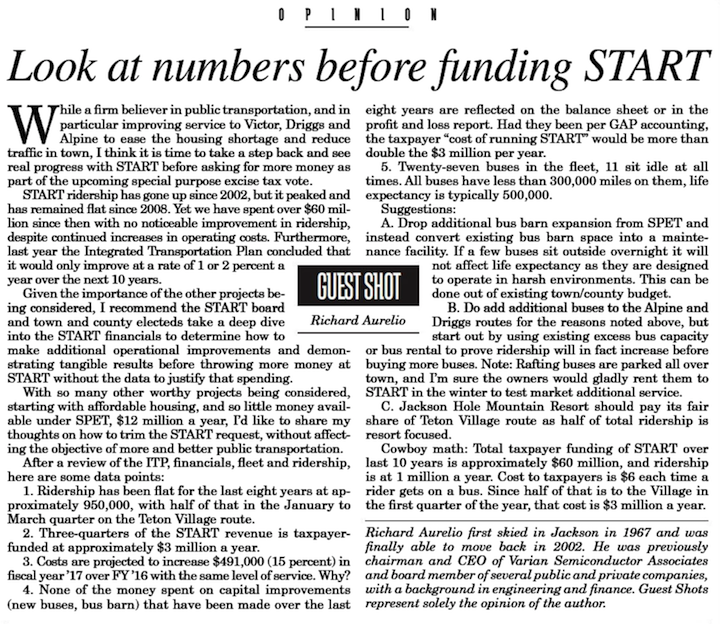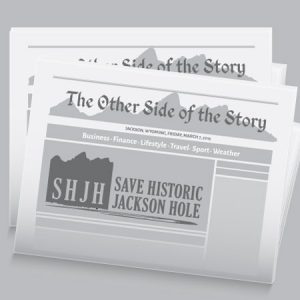
START Bus debunked
We enjoyed the common sense of Dick Aurelio regarding START Bus.
This Guest Shot was printed March 1, 2017.
O P I N I O N
Look at numbers before funding START
While a firm believer in public transportation, and in particular improving service to Victor, Driggs and Alpine to ease the housing shortage and reduce traffic in town, I think it is time to take a step back and see real progress with START before asking for more money as part of the upcoming special purpose excise tax vote.
START ridership has gone up since 2002, but it peaked and has remained flat since 2008. Yet we have spent over $60 million since then with no noticeable improvement in ridership, despite continued increases in operating costs. Furthermore, last year the Integrated Transportation Plan concluded that it would only improve at a rate of 1 or 2 percent a year over the next 10 years.
Given the importance of the other projects being considered, I recommend the START board and town and county electeds take a deep dive into the START financials to determine how to make additional operational improvements and demonstrating tangible results before throwing more money at START without the data to justify that spending.
With so many other worthy projects being considered, starting with affordable housing, and so little money available under SPET, $12 million a year, I’d like to share my thoughts on how to trim the START request, without affecting the objective of more and better public transportation.
After a review of the ITP, financials, fleet and ridership, here are some data points: 1. Ridership has been flat for the last eight years at approximately950,000, with half of that in the January to March quarter on the Teton Village route.
2. Three-quarters of the START revenue is taxpayerfunded at approximately $3 million a year.
3. Costs are projected to increase $491,000 (15 percent) in fiscal year ’17 over FY ’16 with the same level of service. Why?
4. None of the money spent on capital improvements (new buses, bus barn) that have been made over the last eight years are reflected on the balance sheet or in the profit and loss report. Had they been per GAP accounting, the taxpayer “cost of running START” would be more than double the $3 million per year.
5. Twenty-seven buses in the fleet, 11 sit idle at all times. All buses have less than 300,000 miles on them, life expectancy is typically 500,000.
Suggestions: A. Drop additional bus barn expansion from SPET and instead convert existing bus barn space into a maintenance facility. If a few buses sit outside overnight it will not affect life expectancy as they are designed to operate in harsh environments. This can be done out of existing town/county budget. B. Do add additional buses to the Alpine and Driggs routes for the reasons noted above, but start out by using existing excess bus capacity or bus rental to prove ridership will in fact increase before buying more buses. Note: Rafting buses are parked all over town, and I’m sure the owners would gladly rent them to START in the winter to test market additional service.
C. Jackson Hole Mountain Resort should pay its fair share of Teton Village route as half of total ridership is resort focused.
Cowboy math: Total taxpayer funding of START over last 10 years is approximately $60 million, and ridership is at 1 million a year. Cost to taxpayers is $6 each time a rider gets on a bus. Since half of that is to the Village in the first quarter of the year, that cost is $3 million a year. Richard Aurelio first skied in Jackson in 1967 and was finally able to move back in 2002. He was previously chairman and CEO of Varian Semiconductor Associates and board member of several public and private companies, with a background in engineering and finance. Guest Shots represent solely the opinion of the author.
GUEST SHOT
Richard Aurelio
